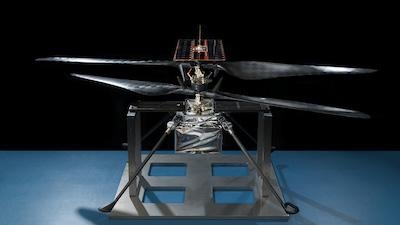NASA/JPL Contract for Mars Sample Return Mission
Arlington, Virginia-headquartered AeroVironment, Inc. is an American defense contractor specializing in the design and manufacture of Unmanned Aerial Vehicles (UAVs).

The company is best known for its lightweight human and solar-powered designs, and, in 2023, is the U.S. military's top supplier of small drones—to include the Raven, Switchblade, Wasp, and Puma models.
On 02 May 2023, AeroVironment, announced it had been awarded a $10-million contract by NASA’s Jet Propulsion Laboratory (JPL) to co-design and co-develop rotary-wing concepts germane to NASA’s Mars Sample Recovery Helicopter mission—a near-future initiative by which a series of U.S. and European spacecraft are to journey to Mars for purpose of retrieving and returning to Earth an assortment of Martian regolith samples currently being cached by NASA’s Perseverance rover.
The rotary-wing concepts AeroVironment has been contracted to envisage will build upon architectures integral to NASA’s Ingenuity Mars Helicopter and feature upgraded robotics conducive to enhanced aerial mobility.
AeroVironment engineers previously worked with NASA JPL to co-design and develop the aforementioned Ingenuity Mars Helicopter, which, to date, has completed 52 successful flights on Mars and survived 781 sols exposed in perpetuity to the the Red Planet’s inhospitable environment—thereby vastly outperforming its design objectives.
In the argot of planetary astronomers, the term sol is a truncation of solar day—the interval of time in which a planet completes a single rotation about its axis. On Mars, the duration of one solar day spans 24-hours, 39-minutes, 35.244-seconds—slightly longer than the Earth-equivalent solar day.
AeroVironment’s vice-president and chief technology officer Scott Newbern stated: “Accomplishing the impossible has been AeroVironment’s mission for more than fifty-years and we are excited to be working with the NASA/JPL team again to conquer the next challenge. Ingenuity’s flights on Mars are a giant leap for robotic technology. Now we’re advancing this science further by helping to build helicopters that not only will continue flight on Mars, but also will include apparatus to collect samples to bring back to Earth for this historic mission.”

Within the context of the joint NASA/ESA Mars Sample Return Campaign, the two planned Sample Recovery Helicopters represent a secondary method of sample retrieval. NASA’s Perseverance rover, which has been about the business of collecting Martian atmospheric and soil samples since February 2021, is currently looked upon as the primary means by which subject samples will be delivered to the Sample Retrieval Lander.
Nevertheless, the Sample Recovery Helicopters will expand on Ingenuity's design, adding wheels and gripping capabilities engineered to better the machines’ utility and provide a secondary praxis by which to pick up cached sample tubes left on Mars’s surface by Perseverance. Should NASA’s primary retrieval plan fail, the helicopters will deliver Perseverance’s samples to the Sample Retrieval Lander. Once loaded, the lander will launch from the surface of Mars and rendezvous with a second spacecraft orbiting the Red Planet. The latter vessel, which is to be designed and built by the European Space Agency, will secure the lander and commence the seven-month trip back to Earth, delivering the invaluable Martian samples—which scientists believe may contain evidence of past life—to researchers in the early-to-mid 2030s.
The NASA lander and ESA retrieval craft are slated to launch in 2027 and 2028, respectively.
 Airborne 07.02.25: TikToker Arrested, Vietnam A/L Ground Hit, ATC Modernization
Airborne 07.02.25: TikToker Arrested, Vietnam A/L Ground Hit, ATC Modernization Airborne Affordable Flyers 07.03.25: Sonex HW, BlackShape Gabriel, PRA Fly-In 25
Airborne Affordable Flyers 07.03.25: Sonex HW, BlackShape Gabriel, PRA Fly-In 25 ANN's Daily Aero-Term (07.07.25): Discrete Code
ANN's Daily Aero-Term (07.07.25): Discrete Code Classic Aero-TV: DeltaHawk Aero Engine Defies Convention
Classic Aero-TV: DeltaHawk Aero Engine Defies Convention ANN's Daily Aero-Linx (07.07.25)
ANN's Daily Aero-Linx (07.07.25)




